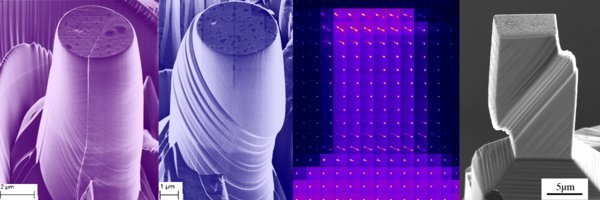
Resolving the deformation mechanisms of intrinsically ductile Mg alloys
The focus lies on the analysis of the mechanical behavior and their underlying deformation mechanisms in new ductile solid solution Mg alloys by performing micromechanical experiments with electron microscopy analyses.
Magnesium and its alloys are the lightest structural material (1.74 g/cm3), two-thirds that of aluminium, one-quarter that of steel and only slightly higher than that of many polymers. Although Mg and its alloys also possess good strength-to-weight ratio, there is a critical factor hindering their use as potential structural materials: poor formability. Its ductilization was up to now only observed in magnesium‐rare earth and magnesium-yttrium alloys: the enhanced ductility may be caused by a high activity of pyramidal <c + a> dislocations as slip modes out of the basal plane. Therefore, this may be the first step to understand mechanical behavior and underlying deformation mechanisms in different type of ductile Mg alloys. Such knowledge would help in the design of even better Mg alloys.
It is clear that deformation mechanism in general mechanical tests (e.g. tensile test) of Mg single crystals remains unclarified. Evaluation of critical resolved shear stress (CRSS) or analysis of deformation behavior for non-basal (pyramidal) slip systems is difficult due to the low CRSS of basal slip. This study aims to investigate CRSS for basal and non-basal slip and the underlying deformation mechanisms in pure Mg and its alloy single crystals will be analyzed by both ex-situ and in-situ micro-shear tests. Shear test would be proper to estimate CRSS for individual slip systems since shear force can be directly loaded to a slip plane.
![Evolution of specimen geometry during shear testing in single-crystalline gold from previous literature result [J.-K. Heyer et al., Acta Mater. 62 (2014) 225.]. (a) Load–displacement curve. (b) Specimen prior to loading. (c) Specimen during shear deformation, shear steps have formed in the left and in the right shear zones. (d) End of the experiment, one shear step in the left shear zone and three shear steps in the right shear zone.](/3754710/original-1518446991.jpg?t=eyJ3aWR0aCI6MTM3OCwib2JqX2lkIjozNzU0NzEwfQ%3D%3D--9bb8252335a72a2c2ba7ab0a188b7837d0b65cb3)
Evolution of specimen geometry during shear testing in single-crystalline gold from previous literature result [J.-K. Heyer et al., Acta Mater. 62 (2014) 225.]. (a) Load–displacement curve. (b) Specimen prior to loading. (c) Specimen during shear deformation, shear steps have formed in the left and in the right shear zones. (d) End of the experiment, one shear step in the left shear zone and three shear steps in the right shear zone.
![Evolution of specimen geometry during shear testing in single-crystalline gold from previous literature result [J.-K. Heyer et al., Acta Mater. 62 (2014) 225.]. (a) Load–displacement curve. (b) Specimen prior to loading. (c) Specimen during shear deformation, shear steps have formed in the left and in the right shear zones. (d) End of the experiment, one shear step in the left shear zone and three shear steps in the right shear zone. Evolution of specimen geometry during shear testing in single-crystalline gold from previous literature result [J.-K. Heyer et al., Acta Mater. 62 (2014) 225.]. (a) Load–displacement curve. (b) Specimen prior to loading. (c) Specimen during shear deformation, shear steps have formed in the left and in the right shear zones. (d) End of the experiment, one shear step in the left shear zone and three shear steps in the right shear zone.](/3754710/original-1518446991.jpg?t=eyJ3aWR0aCI6ODQ4LCJmaWxlX2V4dGVuc2lvbiI6ImpwZyIsIm9ial9pZCI6Mzc1NDcxMH0%3D--f3229488cec6cdab24c44938be552725cded396f)